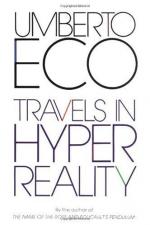
|
| Name: _________________________ | Period: ___________________ |
This test consists of 15 multiple choice questions and 5 short answer questions.
Multiple Choice Questions
1. Hans Sedlmayr was a University Professor of Art History where?
(a) London.
(b) Paris.
(c) Prague.
(d) Vienna.
2. Where was Hans Sedlmayr born?
(a) Hungary.
(b) Italy.
(c) Russia.
(d) England.
3. When classmates sent a naked girl into St. Thomas Aquinas' room when he was trying to become an abbot, what did he do?
(a) Offered her clothes.
(b) Offered her a seat.
(c) Ran at her with a knife.
(d) Chased her out with a hot brand.
4. How many inter-textual archetypes are used in Casablanca, according to Eco?
(a) 24.
(b) 18.
(c) 12.
(d) 15.
5. Eco relates his experience of having the song "Lady Barbara" burst into his head to what?
(a) Laughter.
(b) Anticipatory applause.
(c) Heckling.
(d) Booing.
6. Where was Leon Foucault from?
(a) France.
(b) Morocco.
(c) England.
(d) Spain.
7. What refers to a medium that focuses on a single sense in order to foster a "high power of definition"?
(a) Hot medium.
(b) Wet medium.
(c) Dry medium.
(d) Cool medium.
8. What refers to an original model of a person, ideal example, or a prototype upon which others are copied, patterned, or emulated; a symbol universally recognized by all?
(a) Archetype.
(b) Stereotype.
(c) Prototype.
(d) Inter-textual truth.
9. According to Eco, language encodes power because it forces one to use already formulated what?
(a) Words.
(b) Slang.
(c) Stereotypes.
(d) Speech patterns.
10. In what essay does Eco discuss the qualities of blue jeans?
(a) "Denim Nightmare."
(b) "Levi's Plague."
(c) "Cowboy Pants."
(d) "Lumbar Thought."
11. Where was Roland Barthes from?
(a) France.
(b) Spain.
(c) Italy.
(d) Poland.
12. Who was Aristotle a student of?
(a) Zeus.
(b) William of Ockham.
(c) Socrates.
(d) Plato.
13. When was St. Thomas Aquinas born?
(a) 1225.
(b) 1324.
(c) 1274.
(d) 1374.
14. Eco suggests that power contains both elements of "repression" and excitation, power is "plural," and that power is what?
(a) Engaging.
(b) Epressed.
(c) Exercised.
(d) Elemental.
15. St. Thomas Aquinas was revolutionary in the sense that he was able to do what?
(a) See the future.
(b) Talk to god.
(c) Bring divergent thought together.
(d) Unite different religions.
Short Answer Questions
1. Eco describes Sedlmayr's treatment of art as what?
2. In "A Photograph" Eco references an incident in which a radio station captured the live experience of what?
3. When was Leon Foucault born?
4. When did construction start on the Roman Colosseum?
5. What does Eco describe as "stereotyped situations derived from preceding textual tradition"?
|
This section contains 372 words (approx. 2 pages at 300 words per page) |

|




